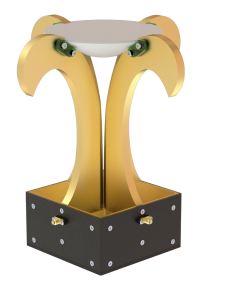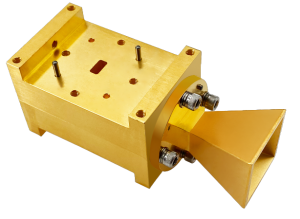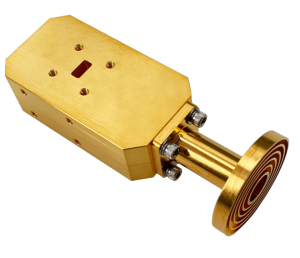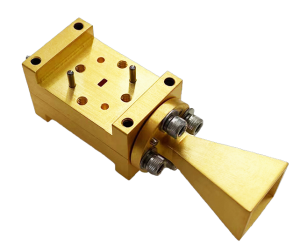The dual-polarized horn antenna can transmit and receive horizontally polarized and vertically polarized electromagnetic waves while keeping the position state unchanged, so that the system position deviation error caused by changing the antenna position in order to meet the requirements of polarization switching is eliminated, and so that the system accuracy can be improved. The dual-polarized horn antenna has the advantages of high gain, good directivity, high polarization isolation, high power capacity, etc., and has been widely studied and used. The dual-polarized antenna can support linear polarization, elliptical polarization and circular polarization waveforms.
Operating Mode:
Receiving Mode
• When the antenna receives a linearly polarized vertical waveform, only the vertical port can receive it, and the horizontal port is isolated.
• When the antenna receives a linearly polarized horizontal waveform, only the horizontal port can receive it, and the vertical port is isolated.
• When the antenna receives an elliptical or circular polarization waveform, the vertical and horizontal ports receive the vertical and horizontal components of the signal, respectively. Depending on the left-hand circular polarization (LHCP) or right-hand circular polarization (RHCP) of the waveform, there will be a 90-degree phase lagging or advancing between the ports. If the waveform is perfectly circularly polarized, the signal amplitude from the port will be the same. By using a proper (90 degree) hybrid coupler, the vertical component and the horizontal component can be combined to restore a circular or elliptical waveform.
Transmitting Mode
• When the antenna is fed by a vertical port, it transmits a vertical line polarization waveform.
• When the antenna is fed by the horizontal port, it transmits the horizontal line polarization waveform.
• When the antenna is fed to the vertical and horizontal ports by a 90-degree phase difference, equal amplitude signals, the LHCP or RHCP waveform is transmitted according to the phase lagging or advancing between the two signals. If the signal amplitudes of the two ports are not equal, the elliptical polarization waveform is transmitted.
Transceiving Mode
• When the antenna is used in the transmitting and receiving mode, due to the isolation between the vertical and horizontal ports, it can transmit and receive at the same time.
RF MISO offers two series of dual-polarized antennas, one based on a quad-ridge structure and the other based on a Waveguide Ortho-Mode Transducer (WOMT). They are shown in Figure 1 and Figure 2 respectively.

RM-BDPHA0818-12, 0.8-18GHz
Figure 1 Dual-polarized quad-ridged horn antenna

RM-DPHA3350-17, 33-50GHz
Figure 2 Dual-polarized horn antenna based on WOMT
The similarities and differences between the two antennas are shown in Table 1. Generally speaking, the antenna based on the quad-ridge structure can cover a wider operating bandwidth, usually more than the octave band, such as 1-20GHz and 5-50GHz. With the superb design skills and high-precision processing methods, RF MISO’s ultra-wideband dual-polarized antenna can work to the high frequencies of millimeter waves. The operating bandwidth of WOMT-based antennas is limited by the operating bandwidth of the waveguide, but its gain, beam width, side lobes and cross polarization/port-to-port isolation can be better. Currently on the market, most dual-polarized antennas based on WOMT have only 20% of the operating bandwidth and cannot cover the standard waveguide frequency band. The WOMT-based dual-polarized antenna designed by RF MISO can cover the full waveguide frequency band, or over the octave band. There are many models to choose from.
Table 1 Comparison of dual-polarized antennas
| Item | Quad-ridge Based | WOMT Based |
| Antenna Type | Circular or Rectangular Horn | All Types |
| Operating Bandwidth | Ultra-wide Band | Waveguide bandwidth or Extended Frequency WG |
| Gain | 10 to 20dBi | Optional, up to 50dBi |
| Side Lobe Levels | 10 to 20dB | Lower, antenna type dependent |
| Bandwidth | Wide range within Operating bandwidth | More stable in the full band |
| Cross polarization isolation | 30dB Typical | High, 40dB Typical |
| Port to port isolation | 30dB Typical | High, 40dB Typical |
| Port Type | Coaxial | Coaxial or waveguide |
| Power | Low | High |
The quad-ridge dual-polarized horn antenna is suitable for applications where the measurement range spans multiple waveguide frequency bands, and has the advantages of ultra-wideband and fast testing. For dual-polarized antennas based on WOMT, you can select various antenna types, such as conical horn, pyramid horn, open ended waveguide probe, lens horn, scalar horn, corrugated horn, corrugated feed horn, Gaussian antenna, dish antenna, etc. A variety of antennas suitable for any system application can be obtained. RF MISO can provide a circular to rectangular waveguide transition module to establish a direct connection between an antenna with standard circular waveguide interface and a WOMT with square waveguide interface. The WOMT-based dual-polarization horn antennas that RF MISO can provide are shown in Table 2.
Table 2 Dual-polarized antenna based on WOMT
| Dual-polarized antenna Types | Features | Examples |
| WOMT+Standard Horn | •Providing standard waveguide full bandwidth and Extended Frequency WG bandwidth
•Frequency covering up to 220 GHz •Low side lobes •Optional gain values of 10, 15, 20, 25 dBi |
RM-DPHA75110-20, 5-110GHz |
| WOMT+Corrugated Feed Horn | •Providing standard waveguide full bandwidth and Extended Frequency WG bandwidth
•Frequency covering up to 220 GHz •Low side lobes •Low cross polarization isolation •Gain values of 10 dBi |

RM-DPHA2442-10, 24-42GHz |
To learn more about antennas, please visit:
E-mail: info@rf-miso.com
Phone: 0086-028-82695327
Website: www.rf-miso.com
Media Contact
Company Name: Chengdu RF Miso Co., Ltd.
Email: Send Email
Country: China
Website: https://www.rf-miso.com/

